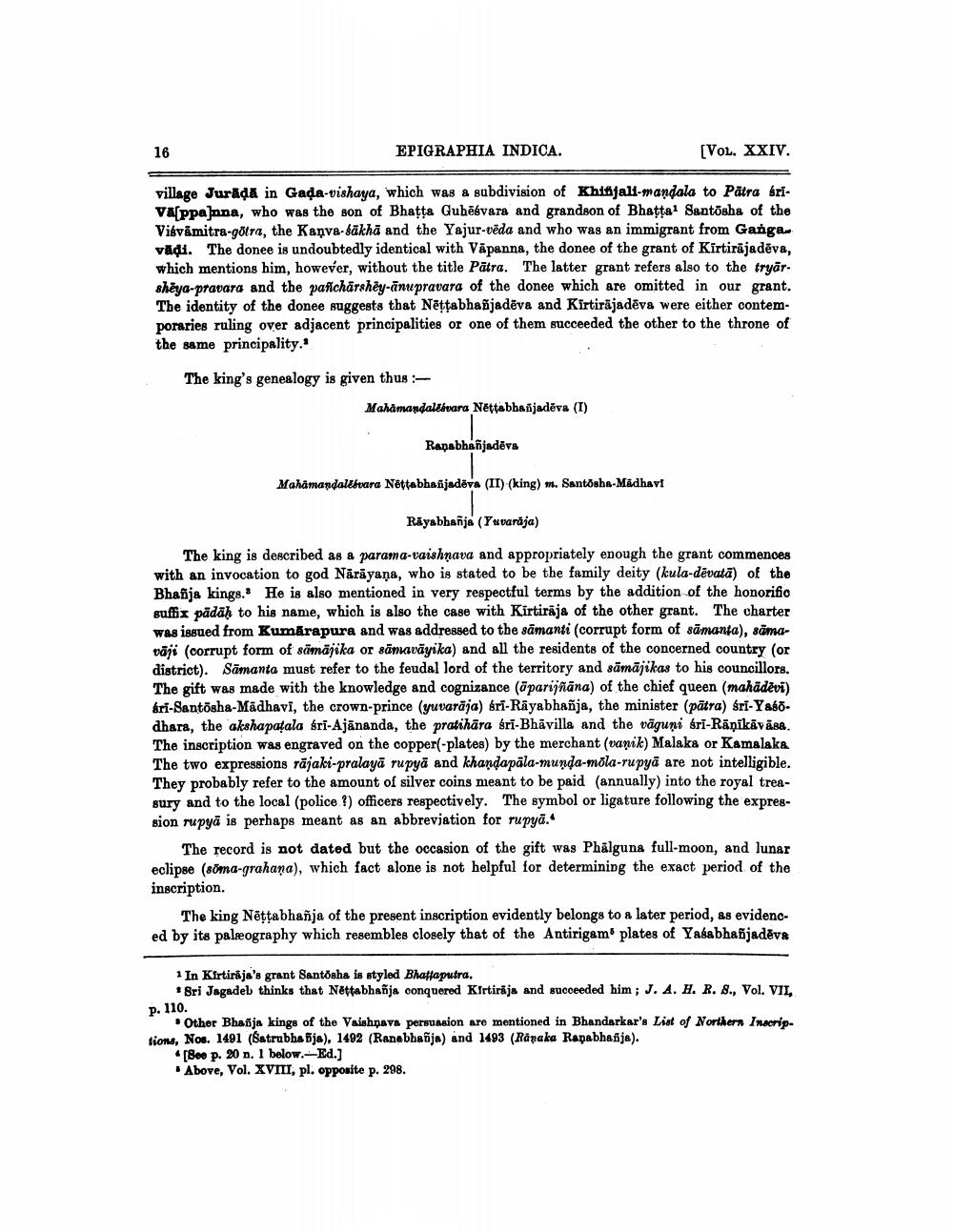________________
16
EPIGRAPHIA INDICA.
(VOL. XXIV.
village Jurāļa in Gada-vishaya, which was & subdivision of Khithjali-mandala to Pātra sriVappanna, who was the son of Bhatta Gubē vara and grandson of Bhatta' Santosha of the Vigvāmitra-gotra, the Kanva-säkha and the Yajur vēda and who was an immigrant from Ganga. vadi. The donee is undoubtedly identical with Väpanna, the donee of the grant of Kirtirajadēva, which mentions him, however, without the title Pātra. The latter grant refers also to the tryār. sheya-pravara and the pafcharshey-ānupravara of the donee which are omitted in our grant. The identity of the donee suggests that Nēttabhañjadēva and Kirtirājadēva were either contemporaries ruling over adjacent principalities or one of them succeeded the other to the throne of the same principality."
The king's genealogy is given thus :
Mahamandaltóvara Nettabbasjadēva (1)
Rapabhañjadėva
Mahamandalstvara Néttabhaijadēva (II) (king) m. Santősha-Madhavi
Räyabhanja (Yuvarāja)
The king is described as a parama-vaishnava and appropriately enough the grant commences with an invocation to god Nārāyaṇa, who is stated to be the family deity (kula-dēvatā) of the Bhañja kings. He is also mentioned in very respectful terms by the addition of the honorifio affis pādah to his name, which is also the case with Kirtiraja of the other grant. The charter was issued from Kumārapura and was addressed to the sāmanti (corrupt form of sāmanta), samavāji (corrupt form of sämājika or sāmavāyika) and all the residents of the concerned country (or district). Samanta must refer to the feudal lord of the territory and sāmājikas to his councillors. The gift was made with the knowledge and cognizance (äparijñāna) of the chief queen (mahadevi) ári-Santosha-Madhavi, the crown-prince (yuvarāja) bri-Rāyabhañja, the minister (patra) sri-Yabā. dhara, the akshapatala śri-Ajānanda, the pratihāra sri-Bhāvilla and the vāguni sri-Rānikāvāsa. The inscription was engraved on the copper(-plates) by the merchant (vanik) Malaka or Kamalaka The two expressions rājaki-pralayā rupyā and khandapāla-munda-mola-rupyā are not intelligible. They probably refer to the amount of silver coins meant to be paid (annually) into the royal treasury and to the local (police ?) officers respectively. The symbol or ligature following the expression rupyā is perhaps meant as an abbreviation for rupyā.
The record is not dated but the occasion of the gift was Phälguna full-moon, and lunar eclipse (sőma-grahana), which fact alone is not helpful for determining the exact period of the inscription.
The king Nēttabhañja of the present inscription evidently belongs to a later period, as evidenced by its paleography which resembles closely that of the Antirigam plates of Yababhañjadēva
1 In Kirtiraja's grant Santosha is styled Bhattaputra.
* Bri Jagadeb thinks that Nottabbañja conquered Kirtiraja and succeeded him; J. A. H. R. 8., Vol. VII. p. 110.
• Other Bhanja kings of the Vaishnava persuasion are mentioned in Bhandarkar's List of Northern Inscriptions, Nos. 1491 (Satrubba Bja), 1492 (Ranabbaõja) and 1493 (Räpaka Ranabhanja).
[800 p. 20 n. 1 below.-Ed.] . Above, Vol. XVII, pl. opposite p. 298.




